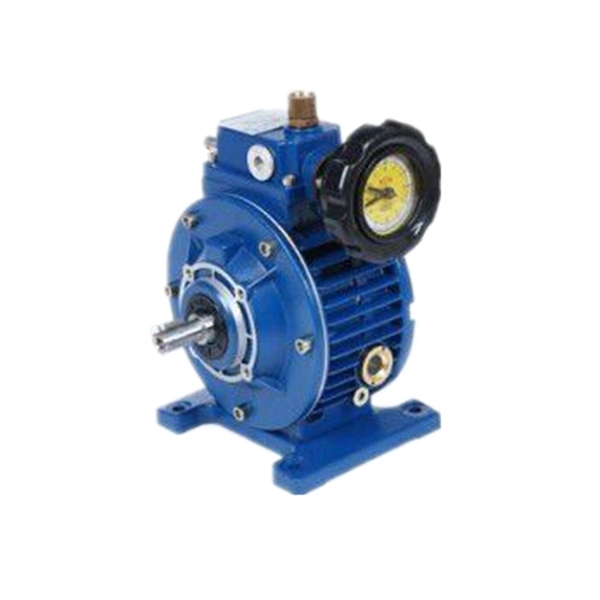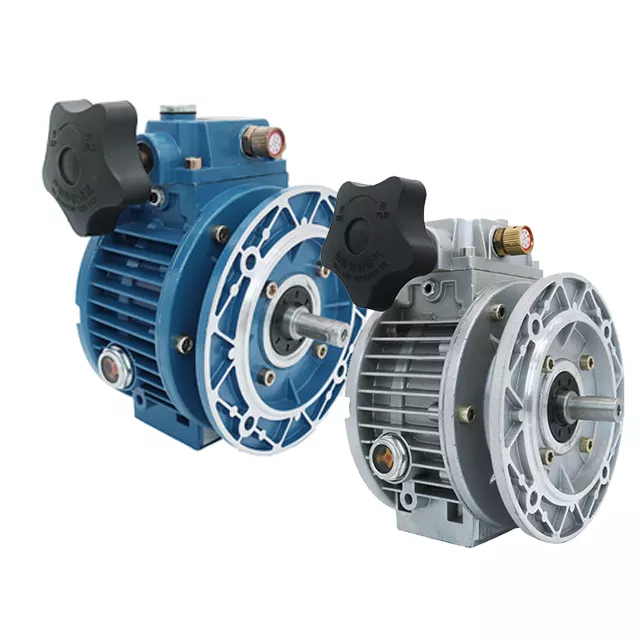Product Description
Stepless speed Variator
High modularity
– Matched with a large range of gearboxes, they are suitable to modular assembling of flanges, feet and torque arms.
High versatility
– 11 sizes, more than 200 versions, with wide range of different mounting positions.
High performances
– Power from 0.18 kW to 7.5 kW.
– Max torque 3000 Nm.
– Up to 6000 Nm when combined with bevel helical gearboxes.
– With the differential device, output speed can be brought to “zero” speed, when the motor is running.
High reliability
– Strengthened box for heavy duty applications.
– Planets and races are made in special steel 100Cr6 and are in oil bath, that guarantee the best conditions of transmission of the motion by friction.
The design of UDL series stepless speed variator compromises the advanced technology both at home and abroad. The products include the following main characteristics:
1. High speed-regulating precision: up to 0.5-1 rotation.
2. Large speed -changing range: The speed ratio ranges from 1:1.4 to 1:7 freely.
3. High in strength and long in service life.
4. Convenient to regulate the speed.
5. Continuous in running, front-to-back in running direction, smooth in driving, stable in performance and low in noise.
6. Full in sealing and suitable for any environment.
7. Compact in structure and small in volume.
8. Made of high-quality aluminum alloy die cast into forming, good-looking in appearance, light in weight and it never gets rusty.
9. Good in adaptation: UDL series stepless speed variators can be combined with all kinds of speed reducers, as to achieve low stepless speed changing.
FAQ
1, Q:what’s your MOQ for udl speed contorller ?
A: 1pc is ok for each type electric gear box motor
2, Q: What about your warranty for your stepless governor ?
A: 1 year ,but except man-made destroyed
3, Q: which payment way you can accept ?
A: TT, western union .
4, Q: how about your payment way ?
A: 100%payment in advanced less $5000 ,30% payment in advanced payment , 70% payment before sending over $5000.
5, Q: how about your packing of speed reduction motor ?
A: plywood case ,if size is small ,we will pack with pallet for less 1 container
6, Q: What information should be given, if I buy electric helical geared motor from you ?
A: rated power, ratio or output speed,type ,voltage , mounting way , quantity , if more is better ,
| Application: | Motor, Machinery, Agricultural Machinery |
|---|---|
| Hardness: | Hardened Tooth Surface |
| Installation: | Horizontal Type |
| Layout: | Bevel |
| Step: | Double-Step |
| Type: | Bevel |
| Customization: |
Available
| Customized Request |
|---|

What maintenance practices are crucial for prolonging the lifespan of variator gearboxes?
Proper maintenance practices are essential for prolonging the lifespan of variator gearboxes and ensuring their optimal performance. By following these crucial maintenance practices, you can maximize the longevity of variator gearboxes:
- Regular Inspections: Conduct regular inspections of the variator gearbox to identify any signs of wear, damage, or abnormal conditions. Inspect the gearbox for leaks, unusual noises, vibrations, and any visible signs of damage or misalignment. Regular inspections help in detecting potential issues early on, allowing for timely maintenance and preventing further damage.
- Proper Lubrication: Ensure proper lubrication of the variator gearbox components. Lubricants reduce friction, wear, and heat generation, thereby extending the lifespan of the gearbox. Follow the manufacturer’s recommendations for lubricant type, quantity, and change intervals. Regularly check the lubricant levels and top-up or replace the lubricant as needed. Proper lubrication is crucial for smooth operation and preventing premature failures.
- Cleaning: Keep the variator gearbox clean and free from dirt, dust, and debris. Regularly clean the exterior of the gearbox using appropriate cleaning methods and materials. Avoid introducing contaminants into the gearbox during cleaning or maintenance procedures. Cleanliness helps in preventing abrasive particles from entering the gearbox and causing damage to the internal components.
- Torque and Tension Checks: Periodically check the torque and tension of fasteners, belts, or chains associated with the variator gearbox. Ensure that they are properly tightened and tensioned according to the manufacturer’s specifications. Loose fasteners or improper belt/chain tension can lead to excessive vibrations, misalignment, and premature wear of gearbox components.
- Alignment: Verify the alignment of the variator gearbox with the connected equipment or shafts. Misalignment can cause increased stress on the gearbox components, leading to accelerated wear and reduced lifespan. Use appropriate alignment tools and techniques to ensure proper alignment, minimizing excessive loads and improving the longevity of the gearbox.
- Temperature Monitoring: Monitor the temperature of the variator gearbox during operation. Excessive heat can indicate issues such as inadequate lubrication, overloading, or improper ventilation. Regularly check the temperature using temperature sensors or thermal imaging techniques. Address any temperature abnormalities promptly to prevent potential damage to the gearbox.
- Condition Monitoring: Implement condition monitoring techniques to assess the health of the variator gearbox. This can include vibration analysis, oil analysis, or other predictive maintenance methods. By monitoring key parameters, such as vibration levels or oil characteristics, potential issues can be detected early, and appropriate maintenance actions can be taken to prevent major failures.
- Training and Documentation: Ensure that maintenance personnel receive proper training on variator gearbox maintenance practices. Familiarize them with the specific procedures, safety guidelines, and recommended maintenance intervals provided by the gearbox manufacturer. Maintain detailed documentation of maintenance activities, including inspections, lubricant changes, repairs, and any abnormalities observed. This documentation helps in tracking maintenance history and identifying recurring issues.
- Manufacturer Guidelines: Always follow the maintenance guidelines provided by the variator gearbox manufacturer. These guidelines may include specific maintenance intervals, recommended spare parts, and detailed instructions for various maintenance tasks. Adhering to the manufacturer’s guidelines ensures that maintenance practices align with the gearbox’s design and specifications.
By implementing these crucial maintenance practices, you can significantly prolong the lifespan of variator gearboxes, minimize downtime, and optimize their performance throughout their operational life.

Are there any limitations or drawbacks associated with variator gearbox systems?
Variator gearbox systems offer numerous advantages, but they also have certain limitations and drawbacks that should be considered. Here are some of the limitations and drawbacks associated with variator gearbox systems:
Limited Torque Capacity:
One limitation of variator gearboxes is their relatively limited torque capacity compared to some other types of gearboxes. Due to the design and construction of variator systems, they may not be suitable for applications that require extremely high torque transmission. In such cases, alternative gearbox systems with higher torque ratings may be more appropriate.
Restricted Speed Ratios:
Variator gearboxes typically have a limited range of achievable speed ratios compared to some other gearbox types. While they offer a continuous and stepless adjustment of the gear ratio, the maximum and minimum achievable ratios may be narrower compared to gearboxes with discrete gear steps. This limitation may restrict their suitability for certain applications that require extremely high or low speed ranges.
Complex Design and Maintenance:
Variator gearboxes can have a more complex design compared to conventional gearboxes. The presence of variable pulley systems, torque-sensing mechanisms, and control systems adds complexity to their construction. This complexity may require specialized knowledge and skills for maintenance and repairs. Additionally, the availability of spare parts and the cost of maintenance can be higher for variator gearboxes compared to simpler gearbox designs.
Potential for Heat Generation:
During operation, variator gearboxes can generate heat due to friction and mechanical losses. The continuous adjustment of the gear ratio and the interaction between the variable pulley system and the belt or chain can contribute to heat generation. Adequate cooling measures and lubrication systems may be necessary to dissipate heat effectively and prevent overheating, especially during prolonged operation at high speeds or under heavy loads.
Efficiency Losses:
While variator gearboxes can maintain reasonable power transmission efficiency, they may experience some efficiency losses compared to certain other gearbox types. The presence of additional components such as variable pulley systems, control mechanisms, and torque-sensing devices can introduce additional friction and mechanical losses, which can slightly reduce overall efficiency. However, advancements in technology and improved designs have mitigated this drawback to a significant extent in modern variator gearbox systems.
Cost Considerations:
Variator gearboxes can be more expensive compared to some traditional gearbox designs. The complexity of their construction, the need for precise control systems, and the use of specialized components can contribute to higher manufacturing and maintenance costs. Therefore, cost considerations should be taken into account when evaluating the feasibility of variator gearbox systems for specific applications.
Despite these limitations and drawbacks, variator gearbox systems continue to offer unique advantages in terms of continuous speed adjustment, efficient power transmission, and precise control. By carefully assessing the specific requirements of an application and considering the trade-offs, it is possible to determine whether a variator gearbox system is the most suitable choice.

How do variator gearboxes handle variations in speed and torque requirements?
Variator gearboxes are designed to handle variations in speed and torque requirements by providing adjustable speed control and flexible torque transmission. Here’s how they accomplish this:
Variator gearboxes handle variations in speed requirements through their unique design and operating principles. They offer continuously adjustable speed control, allowing for stepless variation within a certain range. This is achieved by employing mechanisms that can change the effective gear ratio between the input and output shafts. As the gear ratio is altered, the output speed of the gearbox changes accordingly.
One common method used by variator gearboxes is the manipulation of pulley or cone sizes. For example, in belt-and-pulley variators, the effective diameter of the pulleys can be adjusted by changing their position. This variation in pulley diameter modifies the speed ratio between the input and output, resulting in different output speeds. Similarly, in cone variators, the conical elements change their effective radius as they move closer or farther apart, enabling speed adjustment.
Additionally, variator gearboxes handle variations in torque requirements by providing flexible torque transmission capabilities. They can transmit high torque while maintaining efficiency, ensuring that the necessary power is delivered to the driven system. The specific torque handling capabilities depend on the design and construction of the variator gearbox.
Some variator gearboxes, such as cone variators, are known for their high torque capacity. The conical elements in these gearboxes can withstand substantial torque loads, making them suitable for applications that require robust torque transmission. Other types of variator gearboxes, such as disc variators or hydrostatic variators, are also designed to handle significant torque requirements efficiently.
Furthermore, variator gearboxes can be equipped with additional features to enhance torque transmission. For instance, certain variator gearboxes incorporate mechanisms like friction drives or hydraulic systems that can further optimize torque delivery and handling.
In summary, variator gearboxes handle variations in speed and torque requirements by providing continuously adjustable speed control and flexible torque transmission. Through the manipulation of pulley or cone sizes, variator gearboxes can adjust the effective gear ratio and achieve the desired output speed. Additionally, their design and construction allow them to transmit high torque efficiently, ensuring that the required power is delivered to the driven system. These capabilities make variator gearboxes versatile and adaptable in various applications where speed and torque variations are encountered.


editor by CX 2023-10-19
